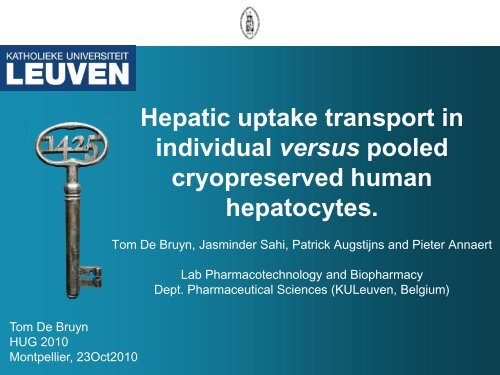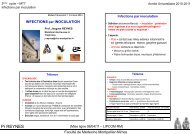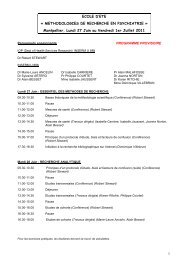Hepatic uptake transport in individual versus pooled ... - Inserm
Hepatic uptake transport in individual versus pooled ... - Inserm
Hepatic uptake transport in individual versus pooled ... - Inserm
You also want an ePaper? Increase the reach of your titles
YUMPU automatically turns print PDFs into web optimized ePapers that Google loves.
<strong>Hepatic</strong> <strong>uptake</strong> <strong>transport</strong> <strong>in</strong><strong>in</strong>dividual <strong>versus</strong> <strong>pooled</strong>cryopreserved humanhepatocytes.Tom De Bruyn, Jasm<strong>in</strong>der Sahi, Patrick Augstijns and Pieter AnnaertLab Pharmacotechnology and BiopharmacyDept. Pharmaceutical Sciences (KULeuven, Belgium)Tom De BruynHUG 2010Montpellier, 23Oct2010
Presentation outl<strong>in</strong>e• Background• Research questions• Methodology• Cryopreserved human hepatocytes to identify new <strong>transport</strong>ersubstrates: <strong>in</strong>dividual <strong>versus</strong> <strong>pooled</strong> batches• Cryoprserved human hepatocytes to evaluate drug <strong>in</strong>teractionpotential: <strong>in</strong>dividual <strong>versus</strong> <strong>pooled</strong> batches• Conclusion
Background: <strong>uptake</strong> <strong>transport</strong> <strong>in</strong> hepatocytesOrganicanions, cationsand bile saltsBile saltsNa+OrganiccationsOrganicanionsSLCOOATP 1B1 1B3 2B1SLCO10A1NTCPSLC22A1/3OCT1/3SLC22A7OAT2BILEhepatocytehepatocyte
Research Questions• Utility of cryopreserved human hepatocytes for identification of<strong>transport</strong>er substrates ?– Evaluate <strong>transport</strong> activities of NTCP, OATP and OCT <strong>in</strong> different batches• Utility of cryopreserved human hepatocytes for identification of<strong>transport</strong>er <strong>in</strong>hibitors ?– Evaluate the effect of different <strong>in</strong>hibitors on the <strong>uptake</strong> of known <strong>transport</strong>ersubstrates <strong>in</strong> different batches.• Are <strong>in</strong>dividual and <strong>pooled</strong> batches equally suited to study hepatic<strong>uptake</strong> <strong>transport</strong> ?– Direct comparison of <strong>pooled</strong> batches and correspond<strong>in</strong>g <strong>in</strong>dividual batches
Methodology: cryopreservation and resuscitation‣ Cryopreservationconducted at Life Technologies (Durham, NC) accord<strong>in</strong>g to <strong>in</strong>-houseprocedures‣ Resuscitation of cryopreserved human hepatocytes• Thaw<strong>in</strong>g cryopreservation vials <strong>in</strong> waterbath @ 37°C• Transfer to recovery medium (CHRM ® medium)• Centrifugation ( 6 m<strong>in</strong>, 76 g)• Re-suspension <strong>in</strong> <strong>uptake</strong> buffer (Krebs Henseleit Buffer pH 7.4)
Methodology: <strong>uptake</strong> experiments‣ Uptake experiments us<strong>in</strong>g “oil-sp<strong>in</strong>” method200 µL SAMPLEoil mixtureNaOH 2 N14.000 rpm2 x 2 m<strong>in</strong>PRE-INCUBATIONcell supsension + buffer/<strong>in</strong>hibitorINCUBATION+ substrate (1 m<strong>in</strong>, 1µM)CENTRIFUGATION STEPto seperate cells from<strong>uptake</strong> bufferQUANTIFICATIONtube bottoms were cut andanalysed by liquid sc<strong>in</strong>tillationspectrometry
Methodology: substrate overview
Research Q 1:Utility of cryopreservedhuman hepatocytes foridentification of<strong>transport</strong>er substrates ?
Q 1:Utility of cryopreserved human hepatocytes foridentification of <strong>transport</strong>er substrates ?Taurocholate (NTCP)MPP + (OCT) Clear substrate accumulation <strong>in</strong> all batches Substrate accumulation values are variable among different batches
Q 1:Utility of cryopreserved human hepatocytesfor identification of <strong>transport</strong>er substrates ?Estrone-3-sulfate (OATP1B)Estradiol-17β-D-glucuronide (OATP1B1)Digox<strong>in</strong> (OATP1B3)
Research Q 2:Utility of cryopreservedhuman hepatocytes foridentification of<strong>transport</strong>er <strong>in</strong>hibitors ?
Q 2:Utility of cryopreserved human hepatocytes foridentification of <strong>transport</strong>er <strong>in</strong>hibitors ?
Research Q 3:Are <strong>in</strong>dividual and<strong>pooled</strong> batches equallysuited to study hepatic<strong>uptake</strong> <strong>transport</strong> ?
Q 3: Are <strong>in</strong>dividual and <strong>pooled</strong> batches equallysuited to study hepatic <strong>uptake</strong> <strong>transport</strong> ?
Q 3: Are <strong>in</strong>dividual and <strong>pooled</strong> batches equallysuited to study hepatic <strong>uptake</strong> <strong>transport</strong> ?Accumulation (% of control)
Conclusions‣ Cryopreserved hepatocytes can be used to identify <strong>transport</strong>ersubstrates.‣ Cryopreserved hepatocytes can be used to identify <strong>transport</strong>er<strong>in</strong>hibitors.‣ Individual and <strong>pooled</strong> batches are equally suited to study hepatic<strong>uptake</strong> <strong>transport</strong>.
AcknowledgementsProf. Pieter AnnaertProf. Patrick AugustijnsDr. Jasm<strong>in</strong>der Sahi (Life Technologies, Durham, NC)Fund<strong>in</strong>g:• Agency for Innovation by Science and Technology, Flanders.• 'Fonds voor Wetenschappelijk Onderzoek', Flanders• 'Onderzoeksfonds' of the Katholieke Universiteit Leuven, Belgium
















